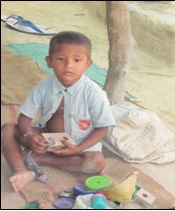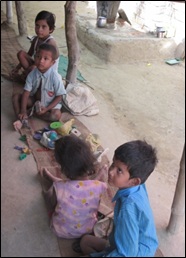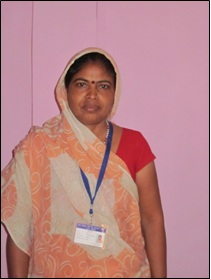
The life and times of Mamta Didi
11 August 2011
 Ask anyone where the Anganwadi Centre (AWC) is in Paschimi Gaon (name changed for privacy) in Lucknow and you are directed to an Anganwadi worker’s house. Its courtyard has a large mat where 15 children aged 3-6 years are sitting, playing with broken toys. The walls are covered with posters of alphabets so faded that they look more than a decade old, and the nearby hand-pump no longer works. This is Mamta Didi’s house, an Anganwadi Worker (AWW) for the past 19 years.
Ask anyone where the Anganwadi Centre (AWC) is in Paschimi Gaon (name changed for privacy) in Lucknow and you are directed to an Anganwadi worker’s house. Its courtyard has a large mat where 15 children aged 3-6 years are sitting, playing with broken toys. The walls are covered with posters of alphabets so faded that they look more than a decade old, and the nearby hand-pump no longer works. This is Mamta Didi’s house, an Anganwadi Worker (AWW) for the past 19 years.
We were in Lucknow as part of a workshop on PAHELI – a Peoples Audit on Health, Education and Livelihoods and one of our tasks entailed interviewing AWW’s about their roles and responsibilities and tracking the amount of money that reaches an AWC.
For those who may be unfamiliar with the Integrated Child Development Services (ICDS) scheme, AWC’s are the main unit of service delivery and have now been acknowledged as the first outpost of health, nutrition and early learning at the habitation level (details of the scheme can be found here and here). Anganwadi Workers (AWW) and Anganwadi Helpers (AWH) thereby are the front-line functionaries at AWC. Over time, AWW’s in the government’s own words “have emerged as the central figure for child care and development under the ICDS scheme”
.
And indeed, take a look at Mamta didi’s job responsibilities and you would amazed at the number of responsibilities she handles – literally covering an entire lifecycle. Even the guidelines (they can be found here) list 21 tasks that an AWW is meant to do. To give a brief idea – every year Mamta Didi’s work starts with a survey of the families in the village to keep track of the number of young children below the age of 6, adolescent girls and pregnant women. She needs to monitor the health of the adolescent girls (kishori’s), and provide them with take home ration/food in accordance with the recently launched Kishori Shakti Yojana (KSY). As soon as a Kishori gets married, Mamta didi is responsible for providing contraceptives to her and once the Kishori plans to have children, give her health advice. Once pregnant, Mamta helps the Primary Health Clinic (PHC) staff and Accredited Social Health Worker(ASHA) with conducting the ante and post natal checkups and then provides the pregnant and lactating mother (erstwhile Kishori) with rations. Once the baby is delivered, she assists the family in birth registration. In addition, she assists the local PHC staff in a myriad of activities including organization of immunization camps and health checkups, measurement of height and weight of children, provision of counselling to caregivers and organization of non-formal pre-school activities. Mamta Didi’s work thus goes much beyond the responsibility of providing nutritional support to children and mothers.
And then there are the registers – a task in themselves!
The Government of Orissa’s Women and Child Development website (link here) for instance pegs the number at 14 registers. These include a family survey register, daily stock register, an immunization register, daily diary, growth monitoring chart, a supervision-cum-visitor book – the list goes on. In addition, the AWWs are also expected to maintain Monthly Progress Reports capturing information ranging from population details, births and deaths of children, maternal deaths, number of children who attended AWC for supplementary nutrition and pre-school education, nutritional status of children by looking at their age appropriate weight, information home visits by AWW etc. These progress reports are meant to be sent to the officers in charge on the 5th day of every month. (For more details on the monitoring mechanisms, see here)
Given the extent of their responsibility, one would imagine that a lot of attention is being paid to the AWC, but that is definitely not the case. To give a few examples:-
1) Infrastructural Facilities: Most AWC’s continue to run from the house of the AWW, with no compensation given to her. While the guidelines mention a rent allowance, during our field visit, no one had heard of such a thing. Most AWCs further lack adequate drinking water and toilet facilities – a fact admitted even by the Minister of Women and Child Development in a reply to a question in the Lok Sabha, when she said, “the Government has information available in respect of 11.13 lakh AWCs/ mini-AWCs in 33 States/UTs according to which 57.48% AWCs have drinking water facilities within the premises and 6.61% AWCs have toilet facilities.” (link available here). Similar findings have been found in evaluations conducted by NCAER and the Planning Commission amongst others and their findings can be found on the ICDS website itself.
2) Kits and small items: While the guidelines mention that a medicine Kit, Pre-school Education Kit, Joint Mother & Child Protection Card, Growth Monitoring Chart and other Petty items such as tumbler, bucket, mug etc. are to be provided to each AWC every year, they usually do not come.
3) Finances: Some of the grants mentioned in a government notification include contingency grants for each AWC, Monitoring and Evaluation grants, monies for replacement of registers, weighing scales etc @ Rs. 200 per functional AWC, a flexi fund of Rs. 1000 per AWC for activities like transportation of ICDS beneficiaries requiring urgent medical care, local innovations, etc. However not ONE of the AWCs we visited had ever heard of the flexifund scheme nor received any such grant. Instead the only thing the AWC had received was a cupboard, a chowky, a medicine kit (of which many medicines had now expired) and a weighing scale many years ago.
4) Food and Rations: The AWC is meant to provide both dry take home rations as well as hot cooked food – the ration of which is supposed to come on a regular basis. However, even this does not come regularly. In the AWC’s we visited, while the dry ration had come the rations for the hot-cooked meal had not come for the past 2 months!
In such a situation, it is hard to imagine how an AWW carries out her many responsibilities, that too at a minimal salary. But there is some hope. Effective from 1st April 2011, the Cabinet Committee on Economic Affairs finally approved the enhancement of Honoraria for Anganwadi Workers to Rs.3000/- from Rs.1500/- per month and for Anganwadi Helpers and Workers of Mini-AWCs to Rs.1500/- from Rs.750/- per month. However, when we had visited Mamta didi in end of May, she and her helper had not even received their previous honorarium of 3 months!
Yet, when you ask her about how she feels to be an AWW, she smiles proudly showing off her recently received “badge” and uniform (a sari worth Rs. 200) and says, “Don’t I look professional- please take a photo!”






